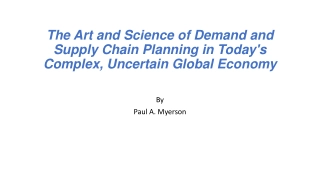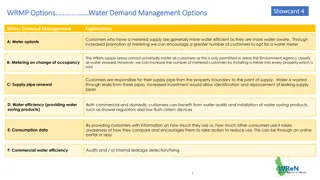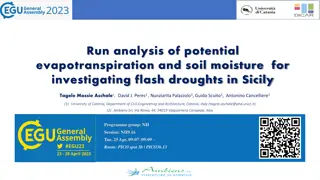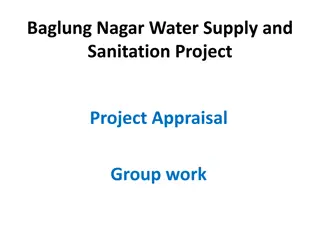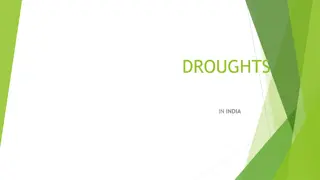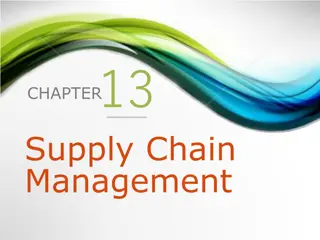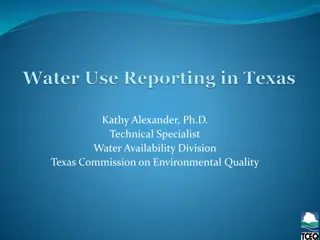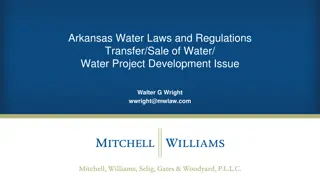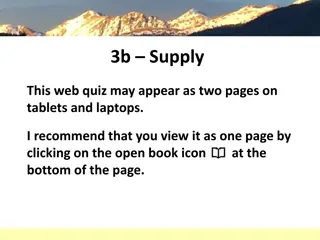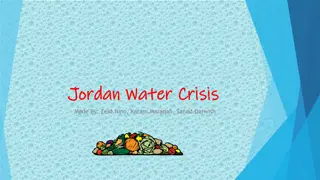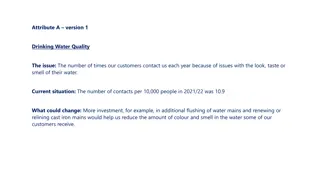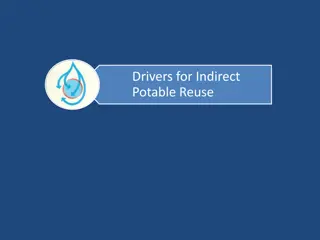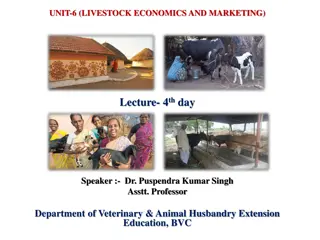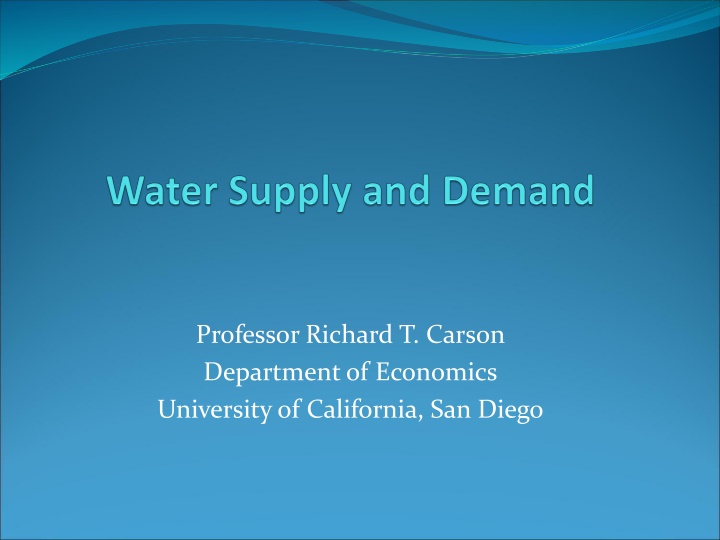
Challenges of Water Supply Amid Severe Droughts
Amid severe drought conditions in California and China, the challenges of modern water supply, including stochastic snowfall, reservoir storage, and legal constraints, are highlighted. Decision-making processes for farmers in allocating land, crops, and water usage are discussed, emphasizing the complexities faced in balancing agricultural needs with environmental concerns and resource limitations.
Download Presentation

Please find below an Image/Link to download the presentation.
The content on the website is provided AS IS for your information and personal use only. It may not be sold, licensed, or shared on other websites without obtaining consent from the author. If you encounter any issues during the download, it is possible that the publisher has removed the file from their server.
You are allowed to download the files provided on this website for personal or commercial use, subject to the condition that they are used lawfully. All files are the property of their respective owners.
The content on the website is provided AS IS for your information and personal use only. It may not be sold, licensed, or shared on other websites without obtaining consent from the author.
E N D
Presentation Transcript
Professor Richard T. Carson Department of Economics University of California, San Diego
USA Today Headline Calif. facing worst drought in modern history Snow pack on Sierra Nevada Mountains 61% of normal 49% northern, 63% central ,68% southern parts Two largest reservoirs at less than half capacity Shasta and Oroville Weather pattern (La Nina) likely to drop water outside of California this year Court order to leave water in rivers to protect fish State of California announces likely to only deliver 15% of contracted water to urban areas and agriculture Bureau of Reclamation to make similar announcement
MSNBC Headline China drought leaves 4 million without water Government declares emergency as millions of acres of crops wither Worst drought in Henan Province since 1951
Key Elements of Modern Water Supply Stochastic Snowfall on Sierra Nevada Mountains stochastic More subtle but important, somewhat predicable/not iid Usage in single year not limited to precipitation Reservoir storage Multiple sources State & Federal projects Not stated in story: local supplies/groundwater Contracts to deliver water Legal/environmental constraints
Simple Case for Farmer Own farm and a groundwater well Aquifer size Recharge rate Pumping cost Have a farm where crops grows better with irrigation Yield as a function of inputs Crop gets some natural precipitation
Decisions How much land to plant What crops to plant Price expectations and responsiveness to water How much land to allocate to each crop How much groundwater to use in different time periods How much to rely on precipitation Changes in behavior when it rains Development of expectations about future rain Simplify the decision making process Only one crop available and all land planted Dryland agriculture assumption with fertile land, enough rain and price support. Planting cost, fertilizer use, pesticides not related to water. One time period for water (right before planting)/rainfall known
Maximization Problem Pump groundwater to maximize present value of discounted profits from growing crop Decide how much water to put on at planting Immediately after observing rainfall
Three Parts of the Water Cost Function Total Cost Quantity of Water
Three Parts of the Water Cost Function Marginal Cost Quantity of Water Free Rain Constant Cost Pumping Pumping Cost + Aquifer Recharges Overdrafting
Marginal Cost Curve Shifts With Changes in Stochastic Rainfall Marginal Cost Quantity of Water Free Rain Constant Cost Pumping Pumping Cost + Aquifer Recharges Overdrafting
Other Pumping Cost Considerations Rainfall Cost can be increasing if need to direct/store water Groundwater pumping less than recharge rate Cost can be increasing if pumping cost go up as water table drops Groundwater pumping greater than recharge rate Can be approximately equal to pumping cost if Aquifer is large enough Neighbor will pump the water if you don t Reason: stored water yields no resource rents
No Groundwater Pumping with Enough Rain Marginal Cost Demand for Water Quantity of Water Free Rain Constant Cost Pumping Pumping Cost + Aquifer Recharges Overdrafting
More Realistic Uncertainty Our simple setup of observe rain, decided on groundwater eliminates important role of uncertainty Major impact of uncertainty is on planting decision If normal rainfall, planting crop is profitable If less than normal, planting crop looses money Major issue in many developing countries With irrigated agriculture uncertainty can enter into decisions in many ways Use groundwater now at optimal (physical) application time or wait for free rain at somewhat less optimal time Substitution of other inputs such for water depends on water cost What is the recharge rate of the aquifer?
Basic Setup for Water Demand Competitive firm (agriculture/industry) With shift from profit to utility and a household production function also works for consumers Output y, inputs x1, , xi , xk, and water w. Price of output, p, price of inputs mi Production function y = f(x1, , xi, , xk, w) f( ) is continuous, twice differentiable in all inputs First derivatives of f( ) with respect to all positive over relevant range with decreasing returns at some point
Production Function All Inputs Fixed at x* Except Water y _ _ _ _ Ymax _ _ _ _ _ _ _ _ _ _ _ _ _ _ _ _ w w
Marginal Production Function All Inputs Fixed at x* Except Water y Increasing Decreasing Returns Returns to Scale y = f/ w w w
Firm Profit Maximization Max p f(x, w) mx c(w), where x, m now vector notation Profit maximization implies p f/ xi = mi
Firm Profit Maximization Max p f(x, w) mx c(w), where x, m now vector notation Take first derivatives and set equal to zero Profit maximization implies usual marginal conditions p f/ xi = mi For water set marginal revenue product equal marginal cost p f/ w = dc/dw Second order condition p 2f/ w2 d2c/dw2 < 0 needs to hold If water is mispriced it will be misused!
Water Demand Function $ p f/ w w w
Quadratic Production Function Profit = p ( 1 + 2w 3w2) w Assuming all other inputs fixed at some level Profit/ w = p ( 2 2 3w) = 0 -p 2 3w = 2p yields water demand: w = ( 2 p )/(2 3 p) Now allow other inputs to vary yields water demand as: w = ( 1 2 2 3(1- 2) ( 2-1) m- 2 p)[1/(1 - 2 3)]
Utility Equivalent Max U[x1, , xi, , xn, w] Subject to c(w) + imi xi = Income (I) w = D[c(w), m1, , mi, , mn, I) Can also constrain utility by rationing w so that wr is less than w* that solve the demand equation above
Water Demand for a Household Water Price pw w* Water Quantity
Oscar Burt 1964 Paper General setup for groundwater (Burt s notation used) Works for many renewable resources s = quantity of resource in stock or reserve x = quantity of resource used from stock per period w = exogenous addition of resource to stock per period G(x, s) = expected net output per period h(w, s) dw = probability density function for additions to stock (s) = expectation of w for a given magnitude of s = (1 + r)-1, where r is the periodic interest rate.
Let f(s) be the present value of net expected output Load economics part into G( ) Assume on optimal path where n represents time periods Use Bellman principle of optimality to get fn(s) = Max x[G(x, s) + fn-1(s + w -x)h(w, s) dw] Now let n go to infinity, fn+1(s) = fn(s) = f(s) so f(s) = Max x[G(x, s) + f(s + w -x)h(w, s) dw] Standard difficulty cannot solve for f(s) Assume specific functional forms Assume G(x, s) same in all periods Take numeric (Taylor-series) approximations G(x, s)/ x f (s) = 0 With assumption w is independent of s: G/ x = (1/r) G/ s
Intuition Burt (1964) Expand production to the point where marginal net output with respect to current consumption of the resource is equal to present value of a perpetual annuity equal in value to marginal net output with respect to quantity of resource in stock. Common to write contribution to out put as G(x, s) = R(x) - c(s)x, where R(x) incremental value before taking account of pumping cost c(s)x Relationship at optimal groundwater pumping is: (R'(x) - c(s))/x = -c'(s)/r Production for the basin is expanded to the point where marginal net output per unit of water is equal to the negative of capitalized marginal pumping costs with respect to water in storage (c'(s) being negative). Right hand side is opportunity cost of pumping now
Temporal Allocation Burt shows: G/ x = (1/r)[ G/ s E(w x)f (s)] Problem greatly simplifies at x=E(w) Interesting questions are what happens if Increase w through augmenting recharge rate Current s is far from optimal Optimal path is to continually draw down aquifer Hetrogeneity in G( ) among producers Production is sufficient to influence input/output prices
Conjunctive Water Use Economics of first explored by Burt in set of 1960 s papers Hard to avoid. Example in Burt 1964 paper has surface water but the properties of combining two source not explored Provencher (1995) and Koundouri (2004) provide recent overviews Simplest view of the world: use cheapest source But the two different sources have very different stochastic and dynamic properties Surface water highly variable Groundwater stable but depletable Both have common property aspects
Provencher (1995) Motivating example: 1976-1977 drought worse since early 1930 s California Department of Water Resources predicts agriculture related losses will be 2.1 billion In 1977, farm income second highest in history What happen? Prices went up Groundwater compensates for surface water In 1975, Central Valley used 15.3M acre fee of surface water/11.7M of groundwater or 26.9M total In 1977, 9.0 surface/18.3M groundwater or 27.3M total
Surface water best though of as flow Building reservoirs changes into a stock Groundwater best thought of as a stock Groundwater recharge thought of as a flow Groundwater has common property aspects Nature of pumping cost and geologic structure of aquifers makes this fundamentally different (slower) than fisheries
Simple Model of Conjunctive Use M identical farms. Each gets allocated s quantity of surface water for free. Can pump ground water with cost function c(xt) where xt is the stock of ground water shared by farmers. (wt) be the net revenue function from using water, wt, where wt=qt + s and qt is the groundwater pumped. Revenue function increasing and concave so derived demand for water downward sloping. Firm chooses qt to maximize (qt + s) c(xt)qt Groundwater stock evolves Xt+1 = xt Mqt + r
Nature of the Problem Individual farmers to not take into account their impact on other farmers by changing xt One solution. Benevolent central planner solves for the qt that maximizes present value of total (over all identical farms) net revenue using Bellman equation. Alternative: define complete property rights to qt for all t Vernon Smith proposes variant of this in 1977/ITQ similarity Missing component is social marginal user cost Competitive/myopic solution: pump until zero benefits Classic tragedy of the commons outcome Adding this social cost component to pumping cost reduces groundwater extraction
Small Number of Farms Places often characterized by a small number of larger farms Reasonable to expect farms to pay attention to how their actions impact each other Open-loop (extraction path) Closed-loop (feedback/state dependent extraction rules) Cooperative solution possible Jointly reduce groundwater pumping Political process often helpful here Non-cooperative race solutions possible Empirical estimates suggest that farmers not much worse than a central planner Major problem is difficulty estimating water demand function
Influence of Stochastic Nature Of Surface Water Flows Key aspect of groundwater as buffer for bad years for stochastic surface water flow recognized early Current models stem from Tsur (WRR, 1990) and Tsur and Graham-Tomasi (JEEM, 1991) Model exploits ability to condition groundwater pumping on observed draw on surface water Show theoretically that buffer aspect of groundwater could be (usually) positive or negative Buffer value can exceed normal value of the water
Large groundwater aquifers and reservoirs can be substitutes for each other If one can use stored water in wet years to recharge groundwater aquifers, they can be complements
Koundouri (2004) Covers some of the same topics as Provencher (1995) Particular emphasis on what has become known as the Gisser-Sanchez effect that difference between competitive solution and central planner not large Where does the value of irrigation show up? Instruments for controlling groundwater externalities Overdrafting Contamination Practical difficulties in implementing reforms
Gisser-Sanchez effect Clashes with theoretical expectation Driven by how aquifer is modeled Homogeneous bathtub with straws Influenced by Strong homogeneity assumptions on farm land quality/technology Unchanging future economic/technology conditions Reasonably high discount rate used Fairly robust to many possible changes Different types of heterogenity increase divergence but effect small Major exceptions: Low discount rate/higher future demand Ability to transfer water off of land
Where Does Value of Irrigation Show Up? Milliman (Land Economics, 1959) & Hartman and Anderson (J. Farm Economics [now AJAE], 1962) estimate early versions of hedonic pricing models showing value of water access incorporated into land price Often used technique to look at water/soil related changes that impact agricultural productivity Recent uses for valuing impacts of climate change on agriculture Continuing controversy over how water is treated
Reducing Groundwater Overdrafting Brown and Deacon (WRR, 1972) propose a tax on groundwater to reach optimal control solution Brown (JPE, 1974) propose a tax on the congestion nature of the externality with multiple farms pumping Permits/withdrawal rights are an obvious alternative Non-transferable versus transferable Major problems Asymmetric information on cost and quantities Expensive monitoring and enforcement costs
Groundwater Contamination Issue largely ignored in initial work In agriculture, recharge of aquifer often assisted by runoff from fields Pesticides, fertilizers ect. Salinity Lowers water quality for all tapping aquifer Third party contamination of aquifers Major issue for cities with contamination coming from multiple sources: old factories, gas station tanks, MBTE
Reform of Groundwater Regulation Usually motivated by conflicts between competing uses and scarce supply Clash of historic (and often customary rather than legal) rights with desire to impose a modern system to deal with various types of externalities and reduce conflict Difficulty with coming up with compensation schemes for those who loose in new system Tying reform to a broader reform package sometimes helps Knowledge of what works is sparse at best
Schoengold and Zilberman (2007) Most of this paper will be covered in a couple of weeks With respect to groundwater make interesting point: Subsidization of electricity encourages excessive groundwater pumping and this has been done in many countries Shah, Zilberman, Chakravorty (1993) show that a second best solution for groundwater extraction can be achieved by taxing the more observable: Use of irrigation technology Agricultural output
Assembling an Urban Water Supply Typical urban area starts out with a fresh water supply River, lake, springs Original source of water played an important locational role As city expanded needed additional water Usually greater control over major fresh water source If fresh water source is inadequate, typically tap inexpensive groundwater If fresh water supply is sufficiently variable, then build storage facilities If still insufficient, acquire more distant source/transport If still insufficient, purchase water from other sources If still insufficient, take steps to conserve existing water
Initial Tradeoffs Water supply versus cost Water reliability versus cost 1 probability of not being able to meet demand (at pw)
Ignoring reliability component, constructing a water supply curve takes the minimum cost way of achieving the given supply level This could be a step function where the cheapest way is used first until it is exhausted, then the next and so on Often consistent with initial part of water supply curve Initial fresh water supplies exhausted before other sources sought As initial sources exhausted, long run supply curve tends to become a mixture of different water sources Largely driven by increasing marginal cost associated with increasing supply from the source
Backstop Technology Over different ranges, the next most expensive source serves as a backstop technology When demand (given price) reaches point where the new source is cheaper, switch occurs Desalination is the ultimate backstop technology for urban water supply
Conservation Water not used is water that does not to be supplied Cost of saving acre foot of water through conservation ranges from very inexpensive to extremely expensive Difficult to favor conservation just because it is conservation Four types of costs Installing technology (e.g., drip irrigation) Reduced service (e.g., free low flow shower head) Inconvenience/time cost (e.g., fixing leaks) Information (e.g., don t know about options) Different conservation options form an important part of the mix for many cities but options need serious evaluation Engineering estimates of water savings often differ from actual savings due to behavior response of households/firms
Relative to work on effectiveness of household energy conservation programs or water conservation in agriculture, little serious work on household water conservation has been done: Much of what is available base on engineering estimates Work on behavior response of households largely lacking A few exceptions: Cameron & Wright (1990) "The Determinants of Household Water Conservation Retrofit Activity," Water Resources Research
Water Reuse Almost always cheaper than desalination Typically cheaper than many conservation measures Sometimes referred to as toilet to tap by opponents Reaction is often to go to a dual use system Water reused allowed for golf course watering Water from sewage treatment plan often cleaner than intake water from a river source
Large Scale Systems Basic economics of large scale systems worked out in Hirshliefer, DeHaven and Milliman (1960) General nature of the problem is need for massive investment in long lived infrastructure Water treatment plant(s) Water pipes to homes/firms Sewage pipes away from homes/firms Sewage treatment plant(s) Issue exist even if it fresh water source/disposal is a large river running through the city
Large Water Supply Infrastructure Big urban areas need huge amounts of water Water ideally high quality But can treat almost anything at increasing cost Need to dispose of lots of water Water quality standards for discharge increasing Cost of replacing and/or expanding infrastructure higher than previous cost on per acre foot basis Many water utilities have a zero profit constraint Coupled with increasing replace/acquisition cost implies current water is being underpriced (and over used)

